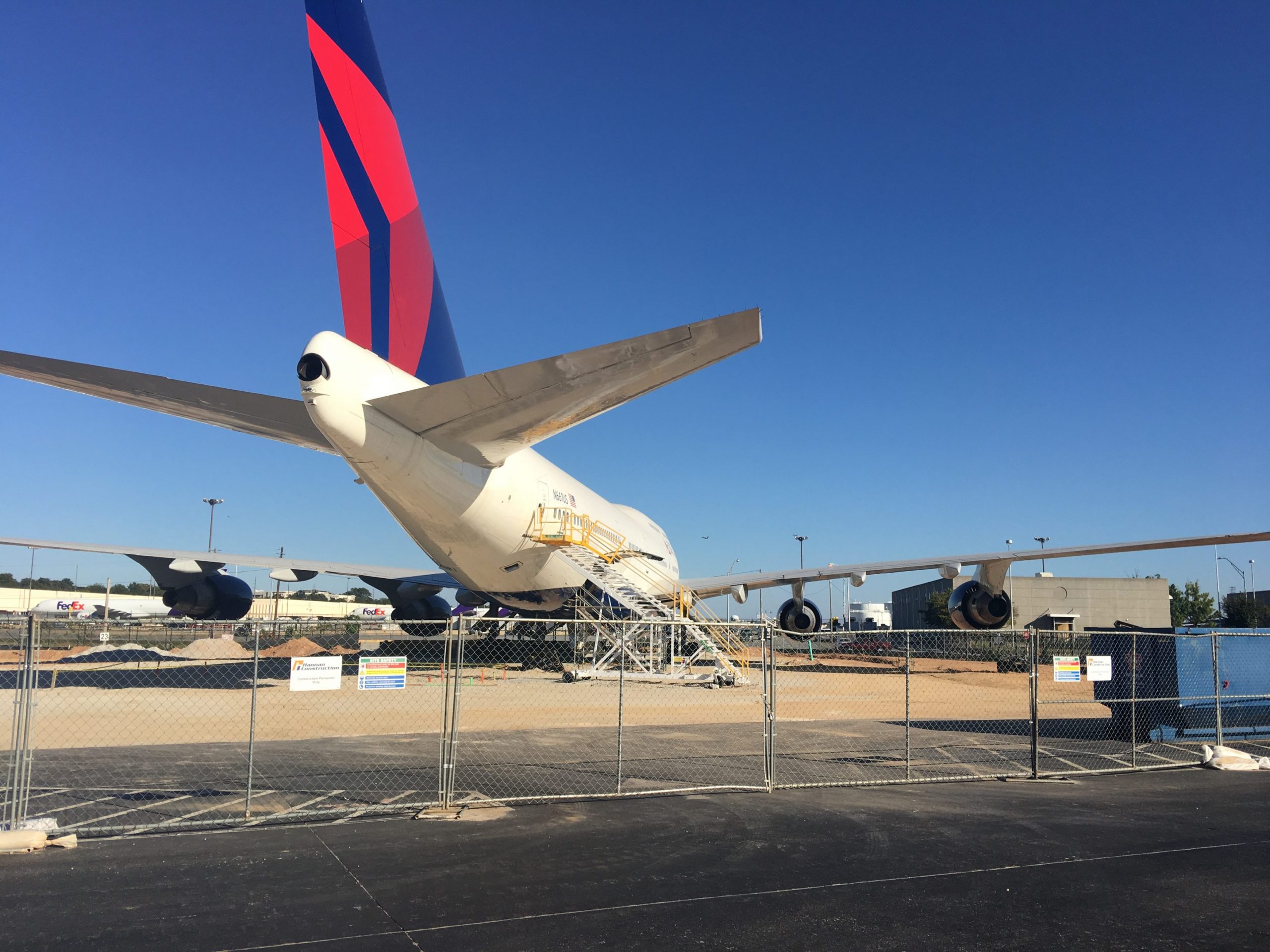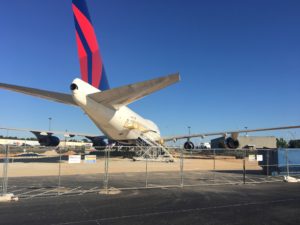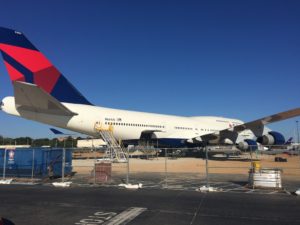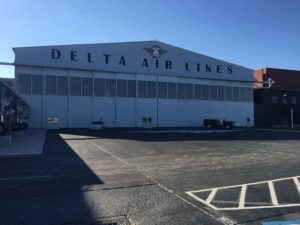

To touch the sky is impossible. But by standing inches away from the 100-foot-long wing of a 367 ton Boeing 767, the clouds don’t feel quite so far away. And in Atlanta, that can only be done in one place.
Housed within Delta’s original 1940 aircraft hangars is the Delta Flight Museum, one of Atlanta’s few aviation museums. Located a short trek from the Hartsfield-Jackson airport itself, the museum’s only neighbors are runways and the roaring planes flying above. The 68,000 square foot establishment is both a walk through history and a portal to the future, with everything from vintage planes to mammoth state-of-the-art jets tucked within.
“We are a nonprofit organization devoted to preserving the history and heritage of Delta and all of the airlines on Delta’s family tree,” Tiffany M. Meng, Director of Operations, said.
The founding of the museum itself was a family matter, a labor of love from Delta retirees who felt Delta’s rich history needed a museum to match. As a show of solidarity, they imported one of Delta’s first DC-3s, a metaltrap of a plane from the 1940s. The plane was sagging with old age and had to be disassembled and restored for five years.
By 1995, a gleaming DC-3 stood proudly in the renovated hangars, and the Delta Flight Museum opened its doors for the first time.
THE HISTORY
Macon, Georgia was home to Huff Daland Dusters, a commercial crop-dusting company that was considered to be the first of its time. Back then, Dusters had a corner on the market in agricultural aviation. Nearly a century later, that same company is now the cornerstone of aviation at large: Delta Airlines.
And the man at the helm of it all was C.E. Woolman, a business tycoon who bought Daland Dusters. He then relocated the company to Mississippi and christened the newborn company “Delta” for the state’s regions. From there Delta would move to Monroe, Louisiana before eventually settling in Atlanta for good.
With change came growth. The airline company expanded in fleet, staff and customer base, and progressed from only offering one intercontinental round trip flight to flying across the world.
Delta employs 80,000 people worldwide, flies more than 800 planes, and offers an average of 15,000 flights per day, according to www.news.delta.com.
THE CITY
Atlanta is one of the largest metropolitan areas in the country, and one of the premiere leading cities in the South. But in 1940, that was not the case.
According to Meng, the aviation industry was booming and C.E. Woolman’s burgeoning airline was in search for a new home. Woolman was torn between the Georgia metropolis and Birmingham, but the Atlanta mayor had a vision for the future that would not be deterred.
Mayor Hartsfield foresaw a symbiotic relationship between Delta and Atlanta and fought for Woolman to base his headquarters here. Woolman agreed, and the two struck up a friendship that altered the course of the city’s history.
“Delta was looking for a new place to move because Monroe was a really small, sleepy farm town,” Meng said. “It’s really cool to think that Atlanta itself was a sleepy farm town, but Mayor Hartsfield really saw a vision for growth and was trying to make it an aviation town. The rise in one inevitably led to the rise in the other.”
Today, the strains of that relationship still exist. The accessibility that Hartsfield offers has led to several headquarters relocating to Atlanta, including Porsche and Mercedes Benz. Delta has also endorsed homegrown companies such as Coke, and when Atlanta hosted the Olympics summer of 1996, Delta designed a special plane just for the occasion.
“It’s been a strong partnership, meaning Delta and the city of Atlanta. Since that time, and throughout the decades,” Brian Kruse, Corporate Communications Program Manager, said. “There wouldn’t be one without the other.”

INSIDE THE MUSEUM
There are two hangars in the Delta Flight Museum and each one serves a different purpose. The first one, dubbed “The Propeller Age,” serves as a time capsule, housing the previously mentioned DC-3, a full scale model of a Huff Daland Duster and a Travel Air.
The duster, a simple aerial crop dusting plane, is a toy in comparison to Delta’s fleet now. But it is monumentally important, because it was the seed of Delta’s innovation.
The Travel Air and DC-3 were a scarce decade apart, but eons apart in terms of technological progression. The Travel Air was the first Delta plane capable of seating passengers, but its neighbor, the DC-3, was their true crowning achievement. Built eleven years later, it could reach nearly double the speed, seat 24 people and was complete with a lavatory, galley and full-meal service.
“The 1930s was a great decade for aviation advancement. We try to display that here at the museum, so you can see from crop dusting to first passengers to the growth of the company,” Meng said.
Hangar two is home to the flight simulator, jets, prototypes and the largest display in the entire museum: the Boeing 767-200, dubbed The Spirit of Delta. The Spirit was Delta’s very first 767,and is the only plane garnered with gold trim. But The Spirit is special for a different reason: in 1982, Delta employees and retirees raised 30 million dollars and bought the plane as a present to Delta.
The Spirit was flown once more for Delta’s 30th anniversary, but now lives out its retirement days as a gallery exhibit for the museum, with most it left intact and dummy flight attendants and pilots frozen in time.
For the museum, it now services as a gallery exhibit, with most of the plane left intact and dummy flight attendants and pilots frozen in time.

DELTA LENDS A HELPING HAND
Both the gifting of the 767 and the opening of the flight museum were labors of love from the employees to the company, but that kind of love is not inspired by good benefits and paid vacation time. It is inspired by a company who first loved them.
The type of company whose founder knew every single name of his hundreds of employees, and who bought a gardenia to work for every woman’s wedding anniversary. The type of company who, when they experienced a recession in the 1970s, refused to lay off any of their 30,000 workers.
“The employees were like this is awesome, the company really took care of us and we want to do something to thank the company,” Meng said.
And in turn, Delta is now showing their gratitude to the community by keeping the museum non-profit. The 501 (c)(3) organizations works with several charities, donating to local fundraising silent auctions, hosting fundraisers for other non-profit organizations and loaning aviation artifacts to other museums. All of the proceeds funnel back into the upkeep and expansion of the museum, all in the name of keeping Delta’s heritage and history alive.
But the true legacy of Delta is not the museum. It is not the restoration of a DC-3, the embodiment of The Spirit of Delta, or its hundreds of artifacts. The true Delta legacy, is its heart.
Elvis’ Expensive Toys: Historic Snippet
The Convair 880 was a record breaker when it was first created in the 1960s. The sleek, compact jet was speed wrapped in elegance: its 84 seats were all first class, and while the Convair served you caviar, it also took you for a joy ride like never before. The jet could push an easy 586 mph, and was the fastest aircraft to roam the skies yet.Renowned entertainer Elvis could be called a speed demon, because in 1975 he bought it for a whopping $250,000 and dubbed the former Delta jet LIsa Marie in honor of his daughter.
Up and coming: Future plans
The museum is currently constructing an outdoor exhibit of a Boeing 747-400, and have plans to create a pavilion around it. Dubbed the “Queen of the Skies,” the aircraft was the first ever 747-400 to be designed by the Boeing Aircraft Company. According to Delta, the notorious jumbo plane had an illustrious career, and was flown from the spring of 1988 until its last flight last summer, on Sept. 9, 2015. After flying more than 60 million miles, its final resting place at the Delta Flight Museum will be their largest display yet.
